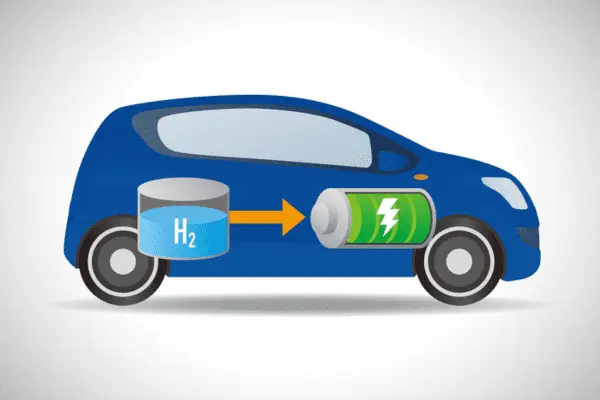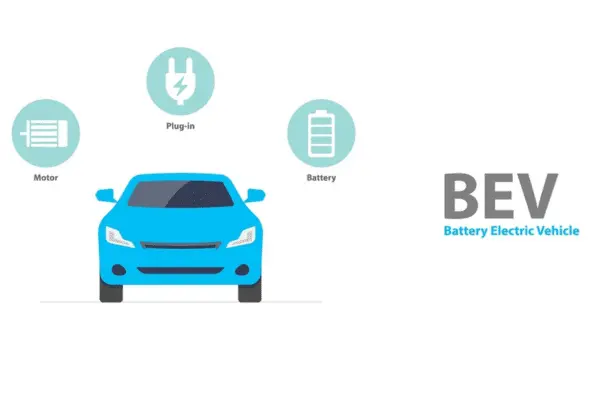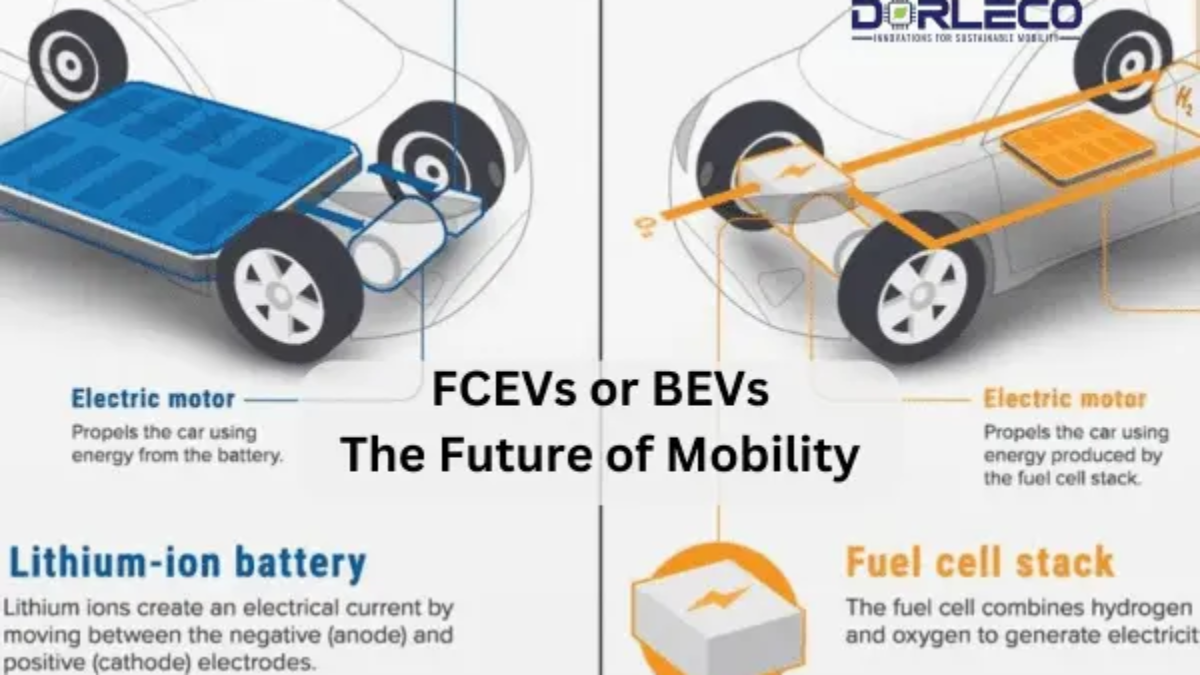Overview
The transportation sector is going through a major transition. Automakers are shifting to alternative powertrains to minimize greenhouse gas emissions and their dependency on finite fossil fuel supplies. Fuel cell electric vehicles (FCEVs) and battery electric vehicles (BEVs) FCEVs or BEVs are two of the top competitors in this race. Although both technologies provide zero-emission solutions, their applications, scalability, energy sources, and infrastructures are very different.
The question of whether to give priority to FCEVs or BEVs emerges as the globe adopts greener mobility alternatives. Better yet, are they able to cohabit to meet various needs? This blog examines their individual responsibilities, salient distinctions, technical possibilities, and Dorleco’s dedication to influencing this electric future.
Understanding the FCEVs or BEVs

The idea that FCEVs or BEVs are direct competitors is a common misconception.
They actually fulfil distinct use cases. BEVs use lithium-ion batteries to store power, but FCEVs use a chemical reaction between hydrogen and oxygen to produce electricity, with the sole by-product being water.
Each technology is positioned differently by one essential distinction:
Because of their immediate torque, great efficiency, and developing charging infrastructure, BEVs are better suited for light-duty, short-distance, and urban transportation.
On the other hand, FCEVs perform exceptionally well in heavy-duty, long-range, high-payload applications where quick refuelling and reduced vehicle weight are essential.
Key Technological Distinctions
| Criteria | FCEVs (Fuel Cell Electric Vehicles) | BEVs (Battery Electric Vehicles) |
| Range | 500–700 km on a single hydrogen fill | 200–500 km depending on battery size |
| Refueling/Charging Time | 5–10 minutes | 30 mins to 12 hours (depending on charger type) |
| Energy Density | High; lightweight system | Lower; battery mass increases vehicle weight |
| Infrastructure | Sparse hydrogen stations | Expanding global EV charging networks |
| Cost | High due to hydrogen production and storage | Becoming affordable with falling battery costs |
| Environmental Impact | Clean emissions, but hydrogen production can be energy-intensive | Clean driving, but lithium mining impacts need consideration |
| Best Suited For | Trucks, buses, long-haul and fleet logistics | Daily commuters, personal vehicles, urban mobility |
Current Issues in the Market
1. Trade-off between Payload and Range
Reaching the ideal payload and range is one of the major obstacles in commercial transportation. Even while internal combustion engine vehicles (ICEVs) can usually travel more than 400 miles on a single tank, it is still difficult to replicate this performance with zero-emission vehicles.
For greater range, BEVs need larger battery packs. These batteries can weigh more than 1,000 kg, though, which has an immediate impact on vehicle payload and energy efficiency.
In contrast, FCEVs have better energy densities and lighter powertrains, which enable longer ranges without sacrificing cargo capacity.
For instance, the battery of a Honda Civic weighs about the same as that of a Hummer EV. A fuel cell stack, on the other hand, uses a lot less weight while yet performing similarly.
2. Costs of Energy and Infrastructure
Infrastructure for Hydrogen: The construction of hydrogen fuelling stations is expensive and scarce. Furthermore, it is still costly and energy-intensive to produce green hydrogen (from renewable sources).
EV Charging Network: Government incentives, standardization, and a quickly growing charging infrastructure are all advantages for BEVs. Charging time and grid capacity are still challenges, though.
3. Resource and Material Limitations
Lithium Supply: The sustainability and environmental effects of mining lithium and cobalt are a worry due to the exponential growth in battery demand.
The majority of hydrogen produced now comes from fossil fuels (gray hydrogen). The process of increasing the production of green hydrogen via electrolysis driven by renewable energy sources is currently ongoing.
Application Suitability:

- BEVs perform well in urban and suburban transit.
- Last-mile delivery services and ride-sharing
- Individual automobiles and compact business vans
In cities where well-established charging networks are in place, public transit systems are increasingly shifting toward electrification to leverage the available infrastructure and reduce emissions.
Where FCEVs Succeed
- Logistics and Long-Distance Freight
- Buses and heavy-duty trucks
- Rail and maritime transportation
- Places where localized hydrogen production is possible but grid connectivity is constrained
The future is a dual-technology strategy, where FCEVs or BEVs complement each other in many industries, as opposed to a winner-take-all situation.
Dorleco’s Dual-Focus Approach
At Dorleco, we think that technological convergence is the key to the future of mobility. Enabling reliable, secure, and scalable software solutions that support both battery and hydrogen-based cars is the main goal of our research and development.
Principal Projects:
1. Equilibrium Cell Algorithms
As part of our commitment to enhancing battery performance and reliability, we develop sophisticated balancing techniques. In turn, these methods help prolong cell life and prevent degradation in lithium-ion battery systems.
2. SOC Estimation using Kalman Filters
Accurate estimation of the State of Charge (SOC) enhances charging behaviour, range prediction, and overall vehicle performance.
3. Modeling of Heat and Control
Both batteries and fuel cells require efficient thermal control. Dynamic modelling and simulation are made possible by Dorleco’s software to avoid overheating and guarantee peak performance.
4. Architecture for Integrated Control
In order to ensure smooth communication and control, our development unifies the Fuel Cell Controller and Battery Management System (BMS) under a single CAN-based architecture.
5. Verification & Validation
Therefore, to guarantee real-world dependability, we conduct stringent testing under various scenarios, including powertrain fault conditions, SOC drift, and charge/discharge cycles.
6. Quick Prototyping
In order to accelerate innovation, we rapidly prototype electric powertrain systems by leveraging state-of-the-art methods. As a result, we facilitate iterative development and enable faster deployment to market.
The Future Adoption Road Ahead: Important Trends
- Reduction in Battery Prices: Advances in battery chemistry, such as solid-state, are making BEVs more economical and efficient.
- Hydrogen Investment: As a sign of a move toward FCEV viability, nations including South Korea, Japan, and Germany are making significant investments in hydrogen infrastructure.
- Vehicle-to-Grid (V2G) Integration: When demand is at its highest, BEVs can serve as energy storage nodes, returning electricity to the grid.
- Sustainability Pressure: Demand for FCEVs or BEVs is being driven by ESG laws that encourage business fleets to switch to zero-emission platforms.
Conclusion
Whether FCEVs or BEVs will rule the transportation landscape in the future is not the question. The most pertinent query is: How can both technologies work together to build a mobility ecology that is genuinely sustainable?
Consequently, as battery technology advances and charging infrastructure becomes increasingly established, BEVs are expected to maintain their dominance in the light-duty urban market.
Long-distance, industrial, and fleet transportation—where rapid recharging and large payloads are crucial—will see a growing role for FCEVs.
At Dorleco, our goal is not to create barriers between technologies but rather to build meaningful connections. Through our advanced software solutions, robust modelling capabilities, and intelligent control systems, we actively support the progression of both powertrain types. As a result, we empower automakers, fleets, and governments in achieving their clean mobility objectives.
Partner with Dorleco
Whether you’re developing FCEVs or BEVs, or hybrid platforms, Dorleco provides tailored solutions to support your journey from design to deployment.
📩 Contact us at: info@dorleco.com
🌐 Explore our offerings: Vehicle Control Units (VCUs), CAN Displays, CAN Keypads, and EV Software Services.
Let’s drive toward a cleaner, smarter, and more sustainable tomorrow—together.


